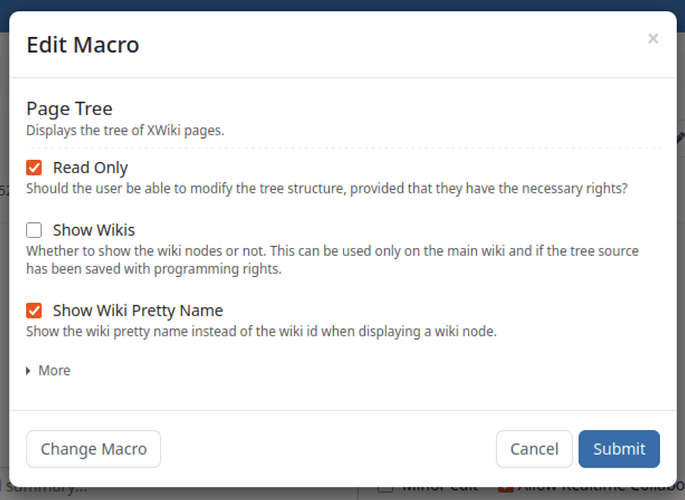Hi everyone,
I’m opening this proposal to discuss the order displayed in the UI when you add or edit a macro, so this UI:
Currently it’s not possible to predefine the order of the parameters, so the behaviour is the following by default:
- Mandatory parameters are displayed first, but only a limited number of parameters
- Advanced parameters are by default “hidden” inside the “More” section
- Whenever a user sets a value for a parameter it stops being hidden
So, for example, my first screenshot was default values of the Page Tree macro, here’s what you have if I select values in the list of parameters present in the More section and I edit again the macro:
You can see that suddenly the UI is entirely different, I don’t see at all the same parameters displayed. I personally find such behaviour confusing, and I will soon work on providing the capability to order the parameters: IMO it would be much simpler to go towards a fixed and immutable order.
@mflorea performed a very good analysis of the questions to solve in Loading... so I’m taking it back here:
-
Should we display all the macro parameters all the time?
Yes: then we use whatever order we get from the macro descriptor; problem fixed
No: Some macros have lots of parameters, most of them optional, some advanced, some deprecated, etc. we display only a limited number of parameters first, with a More button / link -
What’s the expected order between the macro parameters?
A. Either rely only on the order in which the macro parameters are listed / defined in the macro descriptor (assuming that the macro descriptor respects the order in which the macro developer has defined the macro parameters in their code)
B. Or group macro parameters by importance / priority (e.g. mandatory, optional, advanced, deprecated, etc.). Inside each group the macro descriptor order would be used. Open question: should the macro priority change (within its group) when its value is set? -
Is it important for the user to see right away which macro parameters have a value set?
No: then we keep hidden macro parameters with a value set hidden; problem solved
Yes: Then we need to:
A. either show those parameters with a value set that are hidden initially under More => the order between the macro parameters changes
B. we could restore the macro descriptor order once the More button / link is clicked, i.e. when all parameters are shown
C. or indicate somehow to the user that there are some hidden parameters with a value set
My personnal view on those questions is:
-
No: I think we cannot display at once all parameters. If I take back the example of Page Tree macro there’s a lot of parameters and it would be quite tedious for users to show them all
-
B. I honestly didn’t see it coming but I’ve the feeling it could be useful for the users as it’s also giving some info about how the macro works, what they’re allowed to omit or not. For me the order inside the group shouldn’t change when a value is set.
-
C. To be a bit more explicit: I would go for having an immediate visual clue that a value is modified by the user (it’s not default value anymore) in the macro UI (e.g. in my second screenshot it’s difficult to understand that the checkbox Show page title is actually displayed because I uncheked it…), and then I’d display an information about the number of parameters with a value set next to the “more” link. That would allow to keep a fixed order.
WDYT?

